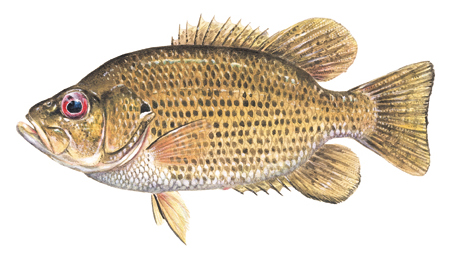Common Names: rock bass, redeye
Habitat
Rock bass occur through most of southern and eastern Ontario, and their distribution is expanding throughout both the northeast and northwest of the province. As the name implies, rock bass are generally associated with shallower, rocky areas of lakes and streams, especially if woody cover is available.
Spawning Patterns
Spawning occurs in late June and early July at temperatures of 60 – 70 ºF (15.6 – 21 ºC). Males build nests in shallow water, in areas ranging from marshes to gravel sites. Nests may be large, up to two feet in diameter. Males aggressively guard the eggs and fry until they disperse (1 to 2 weeks). A single female may lay up to 11,000 eggs.
Diet
Rock bass are very aggressive feeders with a diet consisting of aquatic insects, crayfish and small fish. Recent studies have shown that they can dramatically reduce minnow populations in lakes once they are introduced, reducing food for the larger fish in the lake. Care should be taken not to transport this or any other species of fish from one lake to another.
Age and Size
In established populations, growth of rock bass is generally slow. Rock bass can get quite old, up to 15 years or more. On average, a 6-inch (15 cm) rock bass is four years old, a 9-inch (22.5 cm) fish may be eight years old, and a 10.5-inch rock bass would be approximately ten years old. Growth may vary considerably based on local conditions and population size.
Fishing Tips
Rock bass are very aggressive and will often hit large baits targeted at smallmouth or largemouth bass. They will readily take live bait such as worms or small minnows, as well as artificial lures such as spinners and even small crankbaits. As mentioned earlier, they are often associated with rocky areas in lakes. Docks and boathouses also make excellent cover for rock bass and should not be ignored. They are moderately hard fighters for their size, making them an excellent fish for children to catch. They have white flaky flesh that is delicious.
Fish illustration ©CURTIS ATWATER (www.natureartists.com/atwaterc.htm)









